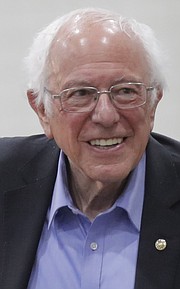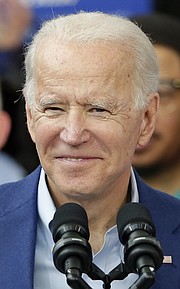Trump, Biden claim Idaho victories
BOISE (AP) — With a majority percent of the state’s precincts reporting, President Donald Trump cruised to a commanding lead for the Republican nomination for president, while it’s a tight race on the Democratic Party ticket between Joe Biden and Bernie Sanders.
In Bonner County, with preliminary results announced at 10:49 p.m., Trump claimed the county vote on the Republican ticket with 3,162 votes, or 94.59% of the vote. Bill Weld received 86 votes, Joe Walsh had 63, Bob Ely had 9 as did Matthew John Matern, and Roque “Rocky” De La Fuente had 14.
On the Democratic Party ticket, former Vice President Joe Biden garnered 1,274 votes, or 47.62%, to 1,126 votes, for Bernie Sanders. Also on the ballot were Michael Bennet, 2 votes; Michael R. Bloomberg, 83; Cory Booker, 1; Steve Burke, 1; Pete Buttigieg, 34; Julian Castro, 0; Roque De La Fuente, 0; John K. Delaney, 0; Tulsi Gabbard, 13; Amy Klobuchar, 35; Deval Patrick, 1; Tom Steyer, 4; Elizabeth Warren, 94; and Marianne Williamson, 0.
On the Constitution Party ticket, Don Blankenship had 7 votes, Daniel Clyde Cummings, 6, Don J. Grundmann, 5, and Charles Kraut, J.R. Myers and Sheila “Samm” Tittle each had 2 votes in the county.
Statewide, Trump had 101,913 votes for 94.47 percent of the vote to clinch the Republic Party nomination in Idaho.
In unofficial results, Weld has 2,246 votes; Walsh, 2,145, Matern, 578; De La Fuente, 571; and Ely, 428.
On the Democratic Party ballot, Biden was declared the winner with 49,635 votes, or 49 percent of the vote, to 43,342 votes, or 42 percent, for Sanders. A total of 921 of 961 precincts had reported results by 11 p.m.
Also receiving votes were Warren, 2,789; Bloomberg, 2,520; Buttigieg, 1,378; Gabbard, 829; Klobuchar, 743; Yang, 282; Steyer, 105; Bennet, 95; Delaney, 59; Booker, 51; Williamson, 48, Castro, 44; Burke, 35; De La Fuente III, 19; and Patrick, 15.
On the Constitution Party ticket, it was Blankenship with 225 votes, Cummings with 120, Grundmann with 83, Kraut with 116, Myers with 108 and Tittle with 176.
Democrats were using a primary for the first time. They used a caucus in 2016 to select Sen. Bernie Sanders over Hillary Clinton. President Barack Obama handily won the Democratic contest in Idaho over Clinton in 2008.
Sanders is in the race again, but now he’ll have to face former vice president Joseph Biden, who drew more than 100 donors at an Idaho event in August.
Brea Barnett, 29, of Boise said she voted for Sanders as the candidate she saw who would best promote health care, the environment and fair wages.
“He stands for the people,” she said.
Sarah Collins, 32, voted in the Democratic primary but declined to name her candidate.
“I believe in human rights and everybody being treated equally,” she said, noting key issues for were abortion-rights and transgender rights.
Officials say switching to a Democratic primary this year from a caucus could significantly increase the number of participants, and play a role in the outcome.
Sanders and Biden are the two big names left on the Democratic side as Sen. Elizabeth Warren dropped out of the race last week.
President Donald Trump is expected to have little difficulty winning the Republican primary, or the state in the November general election. He got Ruth Kyle’s vote on Tuesday.
“I think he’s doing a great job,” she said. “He’s just got the economy going full blast.”
Idaho last year was the nation’s fastest-growing state, with close to 37,000 new residents boosting its population to nearly 1.8 million. That’s a 2.1% population increase.
In the past decade, according to the U.S. Census Bureau, the deeply conservative state has seen a population jump of more than 200,000. Studies indicate many have come from liberal-leaning California, Oregon and Washington.
But it’s not clear if those new residents bringing blue-state politics or are Republicans fleeing the coast for conservative Idaho.
Jaclyn Kettler, a Boise State University political scientist, said it appears Democrats, in general, are moving to urban areas and Republicans to more rural areas, continuing the urban-rural divide between Democrats and Republicans prevalent in states in the U.S. West.
The House went from 11 to 14 Democrats in the 2018 election. Democrats flipped four urban district seats, but lost an urban district in northern Idaho after the incumbent Democrat ran for governor.
Daily Bee staff writer Caroline Lobsinger contributed election results from Bonner County.





